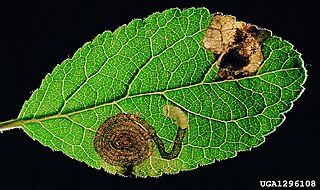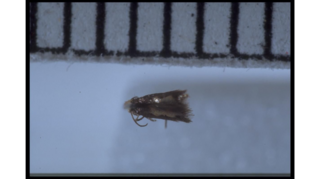
Nepticulidae is a family of very small moths with a worldwide distribution. They are characterised by eyecaps over the eyes. These pigmy moths or midget moths, as they are commonly known, include the smallest of all living moths, with a wingspan that can be as little as 3 mm in the case of the European pigmy sorrel moth, but more usually 3.5–10 mm. The wings of adult moths are narrow and lanceolate, sometimes with metallic markings, and with the venation very simplified compared to most other moths.

Stigmella prunetorum is a moth of the family Nepticulidae. It is found in all of Europe.

Ectoedemia minimella is a moth of the family Nepticulidae. It is widely distributed in the Holarctic.
Stigmella populnea is a moth of the family Nepticulidae. It is only known from Hokkaido in Japan.
Pectinivalva anazona is a moth of the family Nepticulidae. It is found along the Queensland coast of Australia, first described from around Brisbane.

Stigmella aigialeia is a moth of the family Nepticulidae. It is endemic to New Zealand and can be found on both the North and South Islands. The larvae of this species are leaf miners and are known to feed on the leaves of Plagianthus divaricatus. Larvae have been recorded as feeding in April, May and September. They pupate in leaf litter on the ground under their host plant. Adults of this have been observed on the wing in January, February, September and October, in coastal locations particularly in the preferred habitat of its host plant, that is salt marshes and sandbanks.
Stigmella atrata is a moth of the family Nepticulidae. It is endemic to New Zealand and has been observed on the North Island, South Island and Stewart Island. The larvae of this species are leaf miners of Brachyglottis elaeagnifolia and Brachyglottis rotundifolia and have been recorded in April, May, July and September. Larvae pupate on the ground in a cocoon. Adults have been observed on the wing in January, February, November and December. It has been hypothesised that there is probably only one generation per year.

Stigmella cassiniae is a moth of the family Nepticulidae. It is endemic to New Zealand and has been observed in the North and South Islands. The larvae are leaf miners of leaves and stems of Ozothamnus leptophyllus. When mature, the larvae pupate amongst leaf litter on the ground. Adult moths have been recorded on the wing in January, February, April, and October. It has been hypothesised that there are likely two generations in a year.

Stigmella childi is a species of moth of the family Nepticulidae. It is endemic to New Zealand and has been observed in the southern parts of the South Island. This species inhabits subalpine and alpine grassland and herbfields. The larvae of this species are leaf miners and feed on the leaves of Celmisia haastii. Adults have been observed on the wing in January.

Stigmella erysibodea is a species of moth of the family Nepticulidae. It is endemic to New Zealand and has been observed in both the North and South Islands. The larvae of this species are leaf miners and feed on the leaves of Olearia ilicifolia and Olearia albida. Adults have been observed on the wing in November and February.

Stigmella fulva is a moth of the family Nepticulidae. It is endemic to New Zealand and has been observed in the North Island around Mount Taranaki, in the South Island and at Stewart Island. The species' eggs are laid singly but a considerable number may be deposited on the upper surface of one leaf. The incubation period can last from a week to a month depending on climatic conditions. The larvae mine the leaves of their host plants which are all in the genus Olearia. Larvae have been recorded in all months except January, February and June. The cocoon is brown and spun amongst the leaf litter under its host plant. The pupal period has been shown to range from 21 days to 79 days, again depending on climatic conditions. Adults have been observed on the wing January until March and August to December. They are active in the sun about their larval food plant.
Stigmella hakekeae is a moth of the family Nepticulidae. It is endemic to New Zealand and is found in the North, South and Stewart Islands. The larvae feed on Olearia species and are leaf miners. This species pupates in a silk cocoon on the ground underneath its host plant. Adults are on the wing most months of year except for March and April. They have been observed flying during the day near their host plant. There are four or five generations per year. This species is regarded as being widely distributed and locally abundant.

Stigmella hamishella is a moth of the family Nepticulidae. It is endemic to New Zealand and has been observed in the South Island. The larvae mine the leaves of Olearia moschata. The mine consists of blotches, mainly on the lower leaves. The preferred habitat of S. hamishella is the same as its host plant, montane to subalpine shrubland. Adults are on the wing in December.

Stigmella hoheriae is a species of moth of the family Nepticulidae. This day flying moth is found in New Zealand in both the North and South Islands. It inhabits native forest. Eggs are laid on the surface of a still growing leaf of a host plant. Larvae feed on Hoheria species such as Hoheria glabrata, Hoheria populnea, Hoheria sexstylosa and Hoheria angustifolia and have been recorded from February to August. The larvae of S. hoheriae are leaf miners. Their mines create blotches on the host plant leaves. S. hoheriae larvae pupate in a silk cocoon on the ground at the base of their food plant. Adult moths have been observed on the wing in February and from July to December. This species is rarely noticed as it is very small and as a result does not tend to attract attention when on the wing.

Stigmella ilsea is a moth of the family Nepticulidae. It is endemic to New Zealand and has been observed in the North and South Islands. The larvae of this species are leaf miners and feed on Olearia virgata, Olearia rugosa, Olearia odorata, Olearia laxiflora, Olearia lineate and Olearia hectorii. Adult moths have been recorded in January, October and November. Reared specimens emerged from July to September. There is likely one generation per year.

Stigmella kaimanua is a moth of the family Nepticulidae. This species is endemic to New Zealand and has been observed in the southern parts of the South Island. S. kaimanua inhabits lowland and lower montane forest. The larvae mine the leaves of Parsonsia heterophylla. The mine is linear and continues down the stems for a short distance. Larvae have been observed April to August. The cocoon is probably attached to the leaf litter on the ground under the host plant. There is one generation per year. Adults are on the wing in November and December and are attracted to light.

Stigmella lucida is a species of moth of the family Nepticulidae. It is endemic to New Zealand.

Stigmella sophorae is a moth of the family Nepticulidae. It is found in New Zealand.
Stigmella tricentra is a moth of the family Nepticulidae. It is found in New Zealand.

Zimmermannia bosquella is a moth of the family Nepticulidae. It is found in Virginia, Ohio, and Kentucky in the United States. It is now classified as conspecific with the American chestnut moth, which was formerly considered as extinct.














